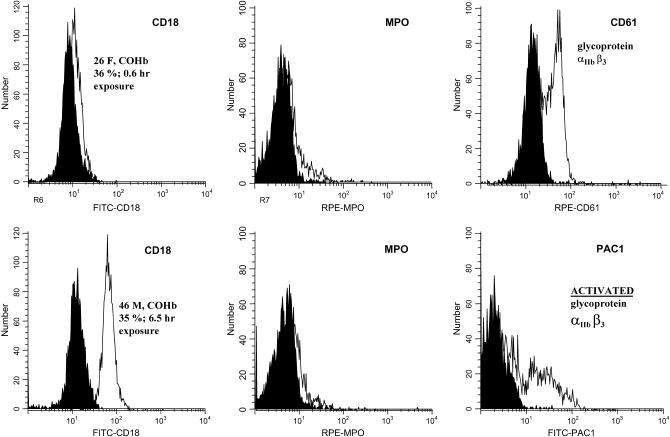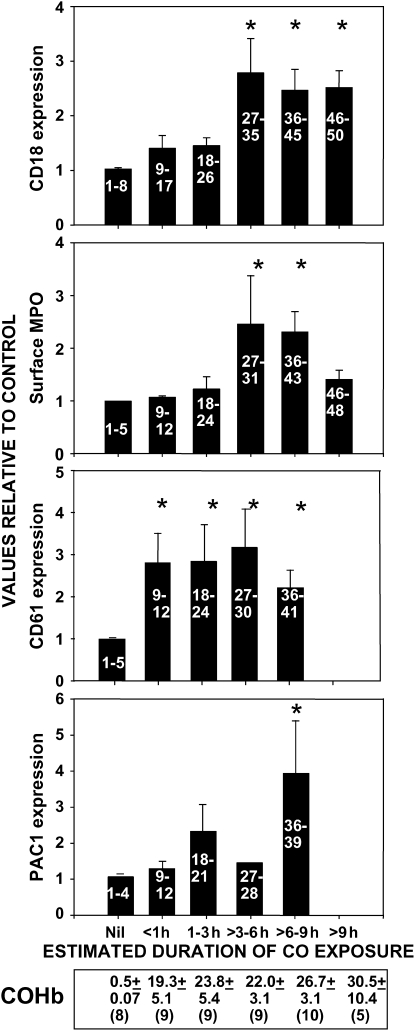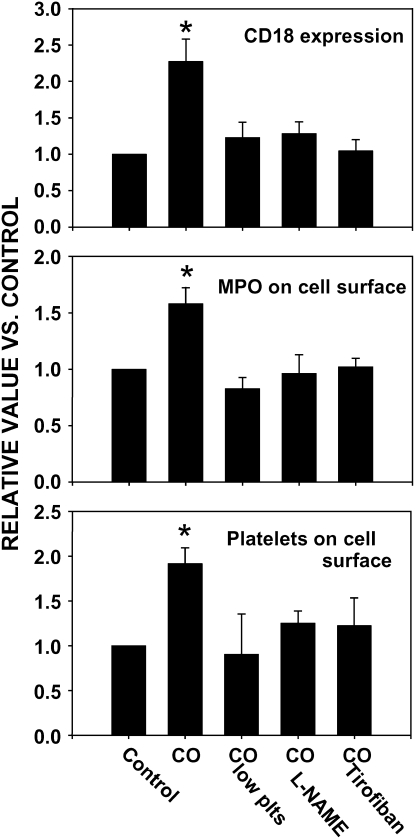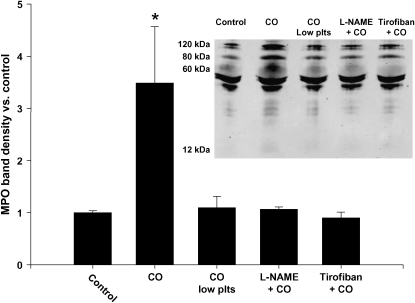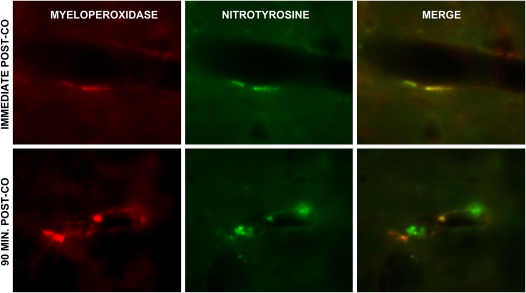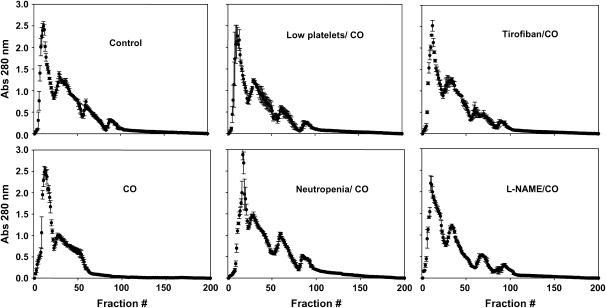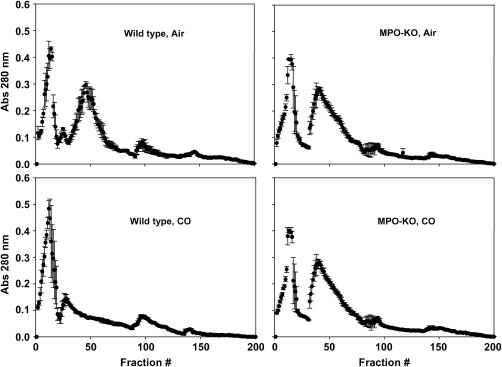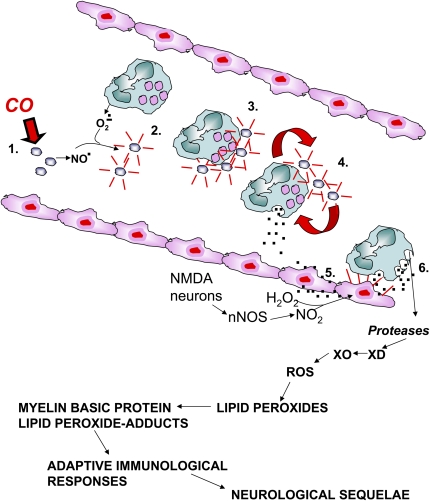Abstract
Rationale: We hypothesized that platelet–neutrophil interactions occur as a result of acute carbon monoxide (CO) poisoning, and subsequent neutrophil activation triggers events that cause neurologic sequelae.
Objectives: To identify platelet–neutrophil interactions and neutrophil activation in patients and in animal models, and to establish the association between these intravascular events and changes linked to CO-mediated neurologic sequelae in an animal model.
Measurements and Main Results: Blood was obtained from 50 consecutive patients. Abnormalities were variable depending on the carboxyhemoglobin level at study admission and duration of CO exposure. Platelet–neutrophil aggregates were detected and plasma myeloperoxidase (MPO) concentration was significantly elevated in those with confirmed CO poisoning. Among patients exposed to CO for over 3 h, flow cytometry scans of neutrophils revealed increased surface expression of CD18 and, in some groups, MPO on the cell surface. Animal models revealed consistent evidence of platelet–neutrophil aggregates, neutrophil activation and surface MPO, and plasma MPO elevation. MPO was deposited along the brain vascular lining and colocalized with nitrotyrosine. CO poisoning caused abnormalities in the charge pattern of myelin basic protein (MBP), changes linked to adaptive immunologic responses responsible for neurologic sequelae in this model. Changes did not occur in thrombocytopenic rats, those receiving tirofiban to inhibit platelet–neutrophil interactions, or those receiving l-nitroarginine methyl ester to inhibit nitric oxide synthesis. Alterations in MBP did not occur in CO-poisoned knockout mice lacking MPO.
Conclusions: Acute CO poisoning causes intravascular neutrophil activation due to interactions with platelets. MPO liberated by neutrophils mediates perivascular oxidative stress, which is linked to immune-mediated neurologic sequelae.
Keywords: myelin basic protein, myeloperoxidase, neuropathology
AT A GLANCE COMMENTARY
Scientific Knowledge on the Subject
Pathophysiologic mechanisms for CO-mediated brain injury are known to extend beyond hypoxic stress due to carboxyhemoglobin, but they are poorly understood.
What This Study Adds to the Field
Platelet–neutrophil activation due to CO poisoning was shown to occur in patients and animal models and platelet–neutrophil aggregation with intravascular neutrophil degranulation was required for one form of CO-mediated brain injury in an animal model.
Carbon monoxide (CO) is the leading agent of injury and death by poisoning worldwide (1). An elevated carboxyhemoglobin (COHb) level can precipitate tissue hypoxia due to direct effects of CO on hemoglobin and because of impaired perfusion from cardiac dysfunction. High COHb levels impair mitochondrial electron transport because CO binds to cytochrome c oxidase. In brain, this has been shown to impair ATP synthesis and increase mitochondrial production of reactive oxygen species (2, 3). Energy production and mitochondrial function are restored after COHb levels decrease, but the transient changes can cause neuronal necrotic or apoptotic death (4–6). These processes are likely to be responsible for neurologic abnormalities that are manifested during initial hospitalization of some patients (7–9).
Neurologic dysfunction may occur in a delayed fashion. Impairments of concentration and learning, dementia, cog-wheel rigidity, amnesia, and/or depression develop in 23 to 76% of patients from several days to approximately 4 wk after poisoning (9–15). The pathophysiology for these sequelae remains unclear. COHb values correlate poorly with clinical outcomes, and even when CO poisoning appears to be relatively mild, delayed neurologic sequelae may still occur (1, 10–18). Therefore, additional pathophysiologic mechanisms beyond COHb-mediated hypoxia are believed to exist.
The goal of this investigation was to determine whether CO poisoning triggers physical interactions between circulating platelets and neutrophils, and whether this association initiates events that can be related to neuropathology. Consideration that CO may stimulate heterotypic (platelet–neutrophil) aggregation was fueled by observations that CO increases the flux of nitric oxide (.NO) released from platelets, apparently because CO and .NO compete for hemoprotein targets (19). When stimulated platelets synthesize .NO or when platelets are artificially loaded with .NO-donating compounds, platelets and neutrophils aggregate (20). This process is believed to be related to production of reactive .NO-associated species, such as peroxynitrite, due to neutrophil-derived superoxide reacting with .NO produced by platelets. Platelet adhesion molecules can be activated by direct addition of peroxynitrite to platelet suspensions (21). Once a physical linkage between platelets and neutrophils is established, neutrophils exhibit a marked increase in oxidative burst and synthesis of additional reactive .NO-derived species (20). Physical associations between neutrophils and platelets can also precipitate neutrophil degranulation (22). We hypothesized that these relatively complex platelet–neutrophil interactions are triggered by CO exposure, and that intravascular neutrophil degranulation will cause additional perivascular changes that mediate neuropathology.
CO can inhibit homotypic (platelet–platelet) adhesion. At concentrations of 10 to 600 μM, CO inhibits aggregation of platelets in purified suspensions through pathways involving cyclic GMP, impaired calcium entry, and inhibition of cytochrome P-450 (23–25). The effect of CO on heterotypic adhesion between platelets and leukocytes has not been investigated in depth. Cigarette smoke, although clearly a more complex stimulus than pure CO, was reported to induce aggregates between leukocytes and platelets in hamsters (26). In experimental settings where homotypic adhesion is inhibited, leukocyte–platelet aggregation is accelerated when platelets are activated (27).
In this article, we show that exposure to CO triggers intravascular platelet–neutrophil interactions that lead to neutrophil degranulation in both experimental animals and patients suffering acute CO poisoning. In the animal model, we show that the myeloperoxidase (MPO) concentration in brain increases due to CO poisoning, MPO is deposited along the vascular lining, and it appears to cause vascular oxidative stress based on colocalization with nitrotyrosine. MPO can catalyze the reaction between nitrite and H2O2 to form nitrogen dioxide (.NO2), which will nitrate local protein tyrosine residues, cause lipid peroxidation, and stimulate expression of endothelial adhesion molecules (28–31). Colocalization of MPO and nitrotyrosine along the subendothelial lining has been found in human tissues after several inflammatory diseases (32).
Recently, we demonstrated that acute CO poisoning triggers an immunologic response that causes functional neurologic deficits (33). Adduct formation between products of lipid peroxidation and myelin basic protein (MBP) causes alterations in the three-dimensional structure and charge pattern of MBP, which initiate an adaptive immunologic response. In this article, we show that neutrophils and platelets are required for CO-mediated charge alterations in MBP. We have directly linked the alterations in MBP with MPO by examining responses in knockout mice lacking MPO. From these data, we conclude that platelet–neutrophil interactions and neutrophil degranulation are major components of CO toxicity.
METHODS
Patients
Analyses were performed on citrate-anticoagulated blood samples obtained from 50 consecutive patients undergoing evaluation for suspected acute CO poisoning. A total of 27 females and 23 males with an average age of 38.5 ± 2.9 (SE) yr (range, 22 mo to 86 yr) were evaluated. These were individuals suspected of suffering CO poisoning either due to faulty home-heating systems, internal combustion engines, or smoke from house fires. Patients were considered to have been exposed to environmental CO if they had a COHb level above 1% and they did not smoke or above 10% if they smoked cigarettes. Table E1 of the online supplement outlines details for these individuals. Among the group, CO exposure was confirmed in all but eight patients.
Animals and Reagents
Wistar male rats were obtained from Harlan Laboratories (Indianapolis, IN). House mice (Mus musculus) of the C57B6J strain were either wild type or lacked a functional MPO gene (MPO−/−). Wild-type mice were purchased from Jackson Laboratories (Bar Harbor, ME) and knockout mice were a generous gift from Dr. Charles Jennette, University of North Carolina at Chapel Hill.
Animal Manipulations
CO poisoning was performed for 1 h according to published protocol in a 7-L Plexiglas chamber (34). Neutropenia and thrombocytopenia were achieved by injecting antiserum as previously described (35). Some rats were injected intraperitoneally with 40 mg/kg l-nitroarginine methyl ester (l-NAME) 30 min before CO poisoning, or with 125 μg tirofiban intravenously plus 500 μg tirofiban intraperitoneally immediately before CO poisoning. At 90 min after CO poisoning, animals were anesthetized, blood was obtained by cardiac puncture into heparinized syringes, and brains perfused with phosphate-buffered saline (PBS) containing 100 U/ml heparin until the effluent was clear.
Tissue Preparation for Chemical Assays
Brain tissue was processed for Western blotting and for column chromatography as described previously (33, 36).
Immunohistochemistry
Immunohistochemistry was performed on paraffin-embedded sections after perfusion/fixation of anesthetized rats following published methods (33, 35–37).
Analysis of Blood
Within 5 min after obtaining blood from rats and mice, or 30 min for humans, 0.5 ml was combined with an equal volume of 0.5% paraformaldehyde in PBS, and stored at 4°C until being stained with antibodies for flow cytometry. Remaining blood was centrifuged at 250 × g for 10 min and supernatant plasma was frozen at −20°C. Plasma MPO concentration for rats and the first eight patients was assessed by Western blots. Thereafter, plasma from patients was analyzed using a commercial MPO ELISA. MPO content of rat neutrophils was assessed by lysing cells and measuring MPO activity as the elevation in light absorption at 460 nm/min/1 × 106 neutrophils in solutions containing ortho-diansidine following published methods (37).
Flow Cytometry
Formalin-fixed blood samples from rats, mice, and humans were processed in a similar fashion following the method of Li and colleagues (38) with minor modifications. Blood samples were incubated with saturating concentrations of antibodies for 30 min at room temperature, and with a cell-permeable anthraquinone, DRAQ5, to stain cell DNA. Neutrophils were identified by DRAQ5 staining, forward and side laser light scattering (see the online supplement). Studies were always coupled with analyses of control cells, either cells from air-breathing animals or from a normal healthy human volunteer.
Statistics
Statistical significance was determined by analysis of variance followed by the Dunn's test (SigmaSTAT; Systat Inc., Richmond, CA).
RESULTS
Intravascular Neutrophil Activation Occurs in Humans with CO Poisoning
Blood samples were obtained from 50 consecutive patients evaluated for suspected acute CO poisoning. Over the course of the trial, the number and type of studies were expanded as more was learned from the animal models. Therefore, not all tests were performed on blood samples obtained from every patient.
Expression of the CD18 epitope of β2 integrins was assessed by flow cytometry as a measure of neutrophil activation on all blood samples. Several examples of flow cytometric results are shown in Figure 1. The pattern and magnitude of CO exposure varied among the patients, and when CD18 expression level was plotted versus either the admission COHb level or an estimated exposure index calculated as COHb multiplied by duration of CO exposure, only a poor correlation was noted (data not shown). When samples were grouped and analyzed simply according to the duration of exposure, a significant elevation in CD18 expression was noted for patients exposed to CO for longer than 3 h (Figure 2). The COHb for patients was assessed as part of standard clinical evaluations using blood obtained on admission to the emergency department. The mean values for each group are listed at the bottom of Figure 2 and individual values for each patient are shown in Table E1.
Figure 1.
Representative neutrophil histograms for human control subjects and CO-poisoned patients. The top three panels show results for cells from a control person (black curves) and results for cells obtained from a 26-yr-old woman who presented to the emergency department after exposure for approximately 0.6 h to smoke in a house fire. Her presenting COHb level was 36%, and she suffered no loss of consciousness. A small shift in surface expression of CD18 and MPO was observed, and there was a moderate presence of platelets attached to neutrophils based on neutrophil surface expression of CD61, the β3 component of the platelet glycoprotein αIIbβ3 integrin. The lower three panels show results for a different control person from the one in the upper panels, and surface expression for neutrophils from a 46-yr-old man exposed to CO from a faulty home heater for approximately 6.5 h. His COHb level on admission was 35% and he had suffered transient loss of consciousness. His neutrophils exhibited a substantial increase in surface CD18 expression, mild presence of myeloperoxidase (MPO), and activated platelet glycoprotein αIIbβ3 integrin. FITC = fluorescein isothiocyanate; RPE = R-phycoerythrin.
Figure 2.
Expression of selected proteins on neutrophils from suspected CO-exposed patients relative to control cells run on the same day. The “nil” group indicates results using neutrophils from patients in whom CO poisoning was not confirmed. Other results are categorized according to the estimated duration of CO poisoning that a patient suffered. Surface CD18 was assessed using cells from all 50 consecutive patients. MPO was measured on the surface of neutrophils from 32 patients, CD61 on cells from 25 patients, and PAC1 on cells from 17 patients. Data are mean ± SE; *p < 0.05, analysis of variance (ANOVA). The numbers within each bar refer to individual patients described in Table E1. The mean COHb (± SE) for each group (n = total number of patients in each group) is shown at the bottom of the figure.
When neutrophils degranulate, some of the liberated MPO can adhere to the cell surface. Subtle elevations of surface-bound MPO were present in many samples, as shown in Figure 1. A significant elevation was identified in two groups (Figure 2). Neutrophil–platelet aggregates were assessed in the neutrophil gate as surface expression of CD61, a component of the platelet glycoprotein αIIbβ3 integrin. An elevation in platelet–neutrophil aggregates was evident and it varied little among the samples, no matter how short the estimated CO exposures or the magnitude of COHb at admission (Figure 2). We also looked for the presence of an epitope on the surface of neutrophils that is recognized by the PAC1 antibody. PAC1 binds only the activated form of platelet glycoprotein αIIbβ3 integrin. Figure 1 shows there was negligible presence of PAC1 binding on cells from a control person, but substantial elevation on cells from a patient who experienced CO poisoning estimated to span 6.5 h. A significant elevation of PAC1 was observed on neutrophils from patients exposed to CO for over 6 h (Figure 2).
Plasma MPO concentration was elevated fivefold in CO-poisoned patients. The mean concentration was 75.7 ± 17.9 (SE; n = 42, p < 0.05, t test) versus 15.0 ± 2.0 (n = 10) ng/ml in control subjects and those in the “nil” group. When analyzed across groups, the plasma MPO value was highly variable, and reached statistical significance in only the group exposed to CO for over 9 h (Table 1).
TABLE 1.
PLASMA MYELOPEROXIDASE VALUES IN PATIENTS
| Nil | < 1 h | 1–3 h | > 3–6 h | > 6–9 h | > 9 h | |
|---|---|---|---|---|---|---|
| MPO, ng/ml | 15.0 ± 2.0 | 117.2 ± 65.4 | 86.7 ± 38.8 | 23.5 ± 6.2 | 57.7 ± 22.5 | 119.4 ± 16.4* |
| Patient numbers | 1–8 | 9–17 | 18–26 | 27–35 | 36–45 | 46–50 |
Definition of abbreviation: MPO = myeloperoxidase.
Values are mean ± SE. Patient numbers refer to the list of patients in Table E1.
p < 0.05, analysis of variance.
Intravascular Neutrophil Activation Occurs in Rats Due to CO Poisoning
Animal studies were conducted concurrent with the clinical investigations. Flow cytometric evaluations were performed on neutrophils obtained from air-breathing and CO-poisoned rats. Typical histograms are shown in Figure 3. Elevations in expression of CD18, MPO, and surface-bound platelets occurred after CO poisoning (Figure 4). Neutrophils were also studied from rats that had been rendered thrombocytopenic or treated before CO poisoning with the nitric oxide synthase (NOS) inhibitor l-NAME or tirofiban to block platelet αIIbβ3 integrin–dependent adhesion. These interventions inhibited the CO-mediated increases in expression of CD18 and MPO and neutrophil–platelet aggregation (Figure 4).
Figure 3.
Representative histograms for expression of markers on the surface of rat neutrophils. Panels show results for cells from a control rat (black curves) and results for cells obtained from a rat poisoned with CO and killed 90 min later. After CO poisoning, the cells exhibited increases in surface expression of CD18 and MPO, and a mild elevation in platelets adherent to the cell surface.
Figure 4.
Relative surface CD18 expression, surface MPO presence, and platelet–neutrophil aggregates for rat neutrophils. Data were obtained for cells from control rats, CO-poisoned untreated rats, those first injected with antiserum to render them thrombocytopenic, rats injected with l-nitroarginine methylester (l-NAME), or rats injected with tirofiban prior to CO poisoning (n = 4 rats in each group). Data are mean ± SE; *p < 0.05, ANOVA. plts = platelets.
Evidence that neutrophils had degranulated in the bloodstream was assessed by measuring MPO activity in cells. MPO activity was 0.85 ± 0.08 (A460 nm/min/1 × 106 neutrophils, SE; n = 5) for control cells and 0.52 ± 0.04 (SE; n = 5; p < 0.05, t test) for cells taken from CO-poisoned rats. For interpretation of these findings, it is important to know that CO does not impede MPO activity (19).
Plasma MPO concentration was elevated in CO-poisoned rats but not in those rendered thrombocytopenic or those pretreated with tirofiban or l-NAME. Figure 5 shows a typical Western blot and the quantitative changes in band density using the heavy chain subunit (60 kD). Results were very similar when light chain (12 kD) band densities were analyzed (data not shown).
Figure 5.
Plasma MPO content in rats. Data were obtained from control rats, untreated CO-poisoned rats, those first injected with antiserum to render them thrombocytopenic, or rats injected with l-NAME or tirofiban prior to CO poisoning. The figure shows a typical Western blot and quantitative evaluations of the 60-kD band density using 50 μg of plasma protein from rats (n = 4 rats in each group). Data are mean ± SE; *p < 0.05, ANOVA.
MPO Elevations in Rat Brains
Western blots were performed on brain homogenates from control and CO-poisoned rats. Only the brains from untreated CO-poisoned rats exhibited a significant elevation in MPO subunit band density, with a relative elevation above control of 2.54 ± 0.17 (SE; n = 4; p < 0.05) (Figure 6). To discern whether MPO elevations were due to neutrophils adherent to brain tissue versus from MPO that may have been released in the bloodstream and then deposited on brain vasculature, blots were also probed for CD66, which is a glycoprotein present in neutrophils and epithelial cells (39). CD66 band density was significantly increased in brains from the untreated CO-poisoned rats (relative elevation, 1.81 ± 0.33 [SE; p < 0.05], above control), but the MPO/CD66 ratio was also significantly elevated (see Figure 6).
Figure 6.
Content of MPO and CD66 protein in brain homogenates from control and CO-poisoned rats. Data were obtained from control rats, untreated CO-poisoned rats, those first injected with antiserum to render them thrombocytopenic, or rats injected with l-NAME or tirofiban prior to CO poisoning. Western blots were prepared and probed with antibody to MPO and to the structural neutrophil CD66 protein (n = 4 rats in each group). Data are the ratio of band density (MPO/CD66), mean ± SE; *p < 0.05, ANOVA.
Immunohistochemical Studies of Brain
Colocalization between perivascular MPO and nitrotyrosine could be clearly discerned in fluorescence micrographs (Figure 7). Immediately after CO poisoning, there was sparse evidence for bona fide neutrophil adherence but, by 90 min after CO poisoning, there was an extensive presence of neutrophils along the endothelial lining. This finding is consistent with previous studies (35, 40).
Figure 7.
Immunohistochemical images of brain sections from rats killed immediately or at 90 min after CO poisoning. Dual staining was performed with an anti-MPO antibody counterstained with Cy3 and an anti–nitrotyrosine antibody counterstained with FITC. Image processing allowed both stains to be overlaid and yellow demonstrated exact colocalization of staining.
Western blots of brain homogenates were also analyzed for the three isoforms of NOS. There were no significant differences between brains from control rats and rats killed 90 min after CO poisoning (Table E2).
MBP Changes Due to CO
The chromatography elution pattern of brain MBP demonstrated the loss of multiple peaks after CO poisoning, as we have reported in previous trials (33, 36) (Figure 8). These changes did not occur in neutropenic or thrombocytopenic rats, or those treated with l-NAME or tirofiban.
Figure 8.
Column chromatography analysis. Panels show the elution patterns of myelin basic protein from cation exchange chromatography columns using acid-soluble brain material obtained from control rats, rats killed 90 min after CO poisoning, and CO-poisoned rats first injected with antiserum to render them thrombocytopenic or neutropenic, or rats injected with l-NAME or tirofiban. Higher fraction numbers indicate more positively charged proteins. Data points are mean ± SE; n = 4 rats in each group.
Mouse CO Poisoning
Based on flow cytometry analyses, circulating neutrophils from wild-type CO-poisoned mice exhibited 1.84 ± 0.22 (SE; n = 6; p < 0.05, t test)–fold greater CD18 expression than did neutrophils from air-breathing wild-type mice. There was a 1.33 ± 0.11 (SE; n = 6; p < 0.05, t test)–fold greater expression of MPO present on the surface of neutrophils from CO-poisoned mice.
The cation-exchange chromatography elution pattern for MBP was markedly altered in wild-type mice due to CO poisoning (Figure 9). Although the pattern in air-breathing MPO-knockout mice was slightly different from that obtained from wild-type mice, the MBP pattern was unchanged due to CO poisoning.
Figure 9.
Column chromatography analysis of acid-soluble material from mouse brain. Panels show the protein elution patterns for wild-type and MPO-knockout (MPO-KO) mice breathing air (control) and at 90 min after CO poisoning. Data points are mean ± SE; n = 3 mice in each group.
DISCUSSION
Results from this investigation indicate that CO exposure triggers platelet–neutrophil aggregation and neutrophil activation in the bloodstream. A role for platelets in neutrophil activation due to CO poisoning is supported by findings that neutrophil activation was significantly reduced in thrombocytopenic rats and also those treated with tirofiban, a platelet glycoprotein αIIbβ3 inhibitor. Detection of activated glycoprotein αIIbβ3 on human neutrophils by the PAC1 antibody further supports involvement of platelets with neutrophil activation. Platelet–neutrophil aggregates were found in all groups of patients, even those exposed to CO for less than 1 h. Because neutrophil activation (CD18 expression) was only significantly increased among patients exposed to CO for over 3 h, we conclude that platelet–neutrophil aggregation precedes neutrophil activation.
The mechanism for platelet–neutrophil interactions is likely to be complex. The inhibitory effect of l-NAME in our trials indicates that .NO synthesis is involved, and .NO-derived oxidants are known to activate platelets (20, 21). In response to a variety of insults, intravascular platelet–neutrophil interactions are mediated initially by platelet P-selectin binding to neutrophil PSGL-1 ligand, and then secondarily by a fibrinogen bridge between platelet glycoprotein αIIbβ3 and neutrophil β2 integrins (27, 41–43). Our observation that tirofiban inhibits platelet–neutrophil aggregation suggests that a dynamic interaction occurs whereby initial contacts involving P-selectin lead to activation of platelet glycoprotein αIIbβ3. Such a process could be mediated by one or more products from closely adherent neutrophils. Chlopicki and colleagues (44) have shown that, when platelets are stimulated by a variety of physiologic stimuli, platelet–neutrophil adhesion involves an initial association mediated by P-selectin, as well as glycoprotein αIIbβ3, platelet activating factor, and neutrophil β2 integrins. Platelet–neutrophil aggregates can also be formed by linkages between β2 integrins and platelet glycoprotein 1α or junctional adhesion molecule-3 (45, 46).
The plasma MPO concentration was variably elevated in CO-poisoned patients. This is likely to be related to the magnitude of neutrophil activation and also clearance of MPO from the circulation. In response to mild stimuli, such as vigorous exercise, plasma MPO can be elevated for as long as 1 h (47). Plasma levels remain elevated for 1 to 5 d after major stresses such as cardiopulmonary bypass (48). Plasma MPO was elevated significantly in patients and animals, indicating that CO poisoning triggers intravascular neutrophil degranulation. In the rat model, approximately 40% of intracellular neutrophil MPO is liberated. Based on flow cytometry results in both animals and humans, some of the released MPO adheres to the surface of neutrophils. This may cause still more neutrophil activation because when MPO binds to β2 integrins it causes “outside-in” neutrophil activation (49). A significant elevation in surface MPO was not observed in patients exposed to CO for over 9 h. Cells from only three patients were analyzed, so it is unknown whether this reflects an aspect of pathophysiology or merely statistical variability.
Previous studies have demonstrated that CO poisoning markedly elevates nitrotyrosine along vascular walls in brain (35, 37). We found that the MPO concentration is increased in brains of CO-poisoned animals. Immunohistochemical investigations indicate that MPO colocalizes with nitrotyrosine, suggesting a causal relationship. We hypothesize that perivascular oxidative stress from MPO may trigger endothelial cell activation and adhesion molecule expression. By 90 min after CO poisoning, neutrophils are firmly adherent to the vascular wall (40). This was documented in the current trial by immunohistochemical images and CD66 elevation on Western blots.
We have shown that neurologic sequelae in the animal model result from an adaptive immunologic response to chemically altered MBP (33, 36). The intravascular events described in this study can be related to chemical changes in MBP because the charge pattern of MBP was preserved if CO-poisoned rats were neutropenic, thrombocytopenic, or treated with l-NAME or tirofiban. MPO is directly involved with brain oxidative stress because alterations in the MBP charge pattern were not observed in CO-poisoned MPO-knockout mice.
N-methyl D-aspartate (NMDA) neurons and neuronal NOS activity are required for development of neurologic sequelae in our animal model (50). We hypothesize that the .NO synthesized in brain in response to CO poisoning leads to higher nitrite levels and that the perivascular MPO focuses oxidative stress at the vascular lining. This may be the reason why the brain, as opposed to other organs in the body, appears particularly sensitive to CO poisoning. We have shown that thrombocytopenic and neutropenic rats exhibit lower NMDA neuronal activation due to CO poisoning (50). This suggests that early intravascular events (possibly perivascular deposition of MPO) are involved with neuronal activation, and this may give rise to a feedback loop of progressive free-radical production. Figure 10 illustrates the events that we believe occur and give rise to immune-mediated neurologic sequelae.
Figure 10.
Schematic illustrating the proposed mechanism for immune-mediated neurologic sequelae. Events numbered 1 through 6 are described in the current study. Additional elements are based on results from published studies (20, 34–36, 38, 41, 51). 1: CO binds to platelet hemoproteins and the competition with intraplatelet .NO increases .NO efflux (first reported in Reference 20). 2: Platelet-derived .NO reacts with neutrophil-derived superoxide (O2−.), giving rise to reactive species that activate platelets and cause platelet–neutrophil aggregates (Step 3). 4: Ongoing interactions involving reactive products and adhesion molecules cause firm aggregation and stimulate intravascular neutrophil degranulation. 5: MPO is deposited along the vascular lining and some is transcytosed to the subendothelial matrix, where it reacts with nitrite generated by N-methyl D-aspartate (NMDA) neurons. Products from MPO-mediated reactions cause endothelial cell activation, facilitating firm neutrophil adhesion and further degranulation. 6: Neutrophil-derived proteases react with endothelial cell xanthine dehydrogenase (XD), converting it to xanthine oxidase (XO). Reactive oxygen species (ROS) initiate lipid peroxidation and adducts interact with brain myelin basic protein. The altered myelin basic protein triggers an adaptive immunologic response that causes neurologic dysfunction. nNOS = neuronal nitric oxide synthase.
Our results do not negate the pathophysiologic importance of hypoxic stress from CO, but they offer a possible explanation for some quizzical observations. Clinical imaging studies have shown that CO poisoning causes vascular injuries in brain. Atypical coupling between cerebral blood flow and neuronal O2 demand and other acute vascular abnormalities have been found in CO victims (51–54). Our findings offer a possible pathophysiologic basis for these observations. Furthermore, recent clinical reports have described a high incidence of cardiac injuries in CO-poisoning patients with normal coronary arteries (55, 56). Platelet–neutrophil interactions may be the basis for many of the CO-mediated cardiac injures. Platelet–neutrophil interactions, reduced neutrophil MPO index (MPO/cell), and elevated intravascular MPO are linked to a heightened risk for acute coronary syndromes (57–59).
In this trial, we were not able to discretely assess whether intravascular neutrophil activation and degranulation were correlated with brain injury in patients. We performed telephone follow-up on all patients, but we did not perform detailed neuropsychologic examinations that are likely to be required to detect some forms of dysfunction (12–14). Only one patient reported difficulty with thinking and activities of daily living when contacted 6 wk after poisoning (see Table E1). We must note, however, that many patients in this investigation received hyperbaric oxygen therapy, which can reduce the incidence of some neurologic sequelae (10, 13, 14, 51). We have shown that hyperbaric oxygen inhibits neutrophil β2 integrin adhesion in both the rat model and humans (60, 61). Recently, we demonstrated in the rat model that hyperbaric oxygen treatment inhibits the CO-induced structural alterations in MBP as well as the associated inflammatory response and learning abnormalities (36). A prospective clinical study to correlate intravascular alterations with neurologic outcome is planned.
Supplementary Material
Acknowledgments
The authors thank the staff of the Department of Emergency Medicine and Institute for Environmental Medicine for their help and cooperation with obtaining blood samples. In particular, they thank J. Michael Stubbs, R.N., and Mary Chin, R.N.
Supported by grant P50AT000428 from the National Center for Complementary and Alternative Medicine.
This article has an online supplement, which is accessible from this issue's table of contents at www.atsjournals.org
Originally Published in Press as DOI: 10.1164/rccm.200604-557OC on August 24, 2006
Conflict of Interest Statement: None of the authors has a financial relationship with a commercial entity that has an interest in the subject of this manuscript.
References
- 1.Raub JA, Mathieu-Nolf M, Hampson NB, Thom SR. Carbon monoxide: a public health perspective. Toxicology 2000;145:1–14. [DOI] [PubMed] [Google Scholar]
- 2.Coburn RF, Forman HJ. Carbon monoxide toxicity. In: Fishman AP, Farki LE, Geiger SR, editors. Handbook of physiology. Baltimore: Williams & Wilkins; 1987. pp. 439–456.
- 3.Piantadosi CA, Tatro L, Zhang J. Hydroxyl radical production in the brain after CO hypoxia in rats. Free Radic Biol Med 1995;18:603–609. [DOI] [PubMed] [Google Scholar]
- 4.Okeda R, Funata N, Song SJ, Higashino F, Takano T, Yokoyama K. Comparative study pathogenesis of selective cerebral lesions in carbon monoxide poisoning and nitrogen hypoxia in cats. Acta Neuropathol (Berl) 1982;56:265–272. [DOI] [PubMed] [Google Scholar]
- 5.Piantadosi CA, Zhang J, Levin ED, Folz RJ, Schmechel DE. Apoptosis and delayed neuronal damage after carbon monoxide poisoning in the rat. Exp Neurol 1997;147:103–114. [DOI] [PubMed] [Google Scholar]
- 6.Gilmer B, Kilkenny J, Tomaszewski C, Watts JA. Hyperbaric oxygen does not prevent neurologic sequelae after carbon monoxide poisoning. Acad Emerg Med 2002;9:1–8. [DOI] [PubMed] [Google Scholar]
- 7.Choi S. Delayed neurologic sequelae in carbon monoxide intoxication. Arch Neurol 1983;40:433–435. [DOI] [PubMed] [Google Scholar]
- 8.Ginsberg MD, Myers RE, McDonagh BF. Experimental carbon monoxide encephalopathy in the primate. II. Clinical aspects, neuropathology, and physiologic correlation. Arch Neurol 1974;30:209–216. [DOI] [PubMed] [Google Scholar]
- 9.Garland H, Pearce J. Neurological complications of carbon monoxide poisoning. Q J Med 1967;263:445–455. [PubMed] [Google Scholar]
- 10.Mathieu D, Wattel F, Mathieu-Nolf M, Durak C, Tempe JP, Bouachour G, Sainty JM. Randomized prospective study comparing the effect of HBO versus 12 hours NBO in non-comatose CO poisoned patients. Undersea Hyperb Med 1996;23:7.8939267 [Google Scholar]
- 11.Raphael JC, Elkharrat D, Guincestre MCJ, Chastang C, Vercken JB, Chasles V, Gajdos P. Trial of normobaric and hyperbaric oxygen for acute carbon monoxide intoxication. Lancet 1989;1:414–419. [DOI] [PubMed] [Google Scholar]
- 12.Scheinkestel CD, Bailey M, Myles PS, Jones K, Cooper DJ, Millar IL, Tuxen D. Hyperbaric or normobaric oxygen for acute carbon monoxide poisoning: a randomized controlled clinical trial. Med J Aust 1999; 170:203–210. [DOI] [PubMed]
- 13.Thom SR, Taber RL, Mendiguren II, Clark JM, Hardy KR, Fisher AB. Delayed neuropsychological sequelae following carbon monoxide poisoning and its prophylaxis by treatment with hyperbaric oxygen. Ann Emerg Med 1995;25:474–480. [DOI] [PubMed] [Google Scholar]
- 14.Weaver LK, Hopkins RO, Chan KJ, Morris AH, Clemmer TP, Elliott CG, Orme JF, Thomas FO, Haberstock D. Hyperbaric oxygen for acute carbon monoxide poisoning. N Engl J Med 2002;2347:1057–1067. [DOI] [PubMed] [Google Scholar]
- 15.Choi S. Delayed neurologic sequelae in carbon monoxide intoxication. Arch Neurol 1983;40:433–435. [DOI] [PubMed] [Google Scholar]
- 16.Remick RA, Miles JE. Carbon monoxide poisoning: neurologic and psychiatric sequelae. Can Med Assoc J 1977;117:654–657. [PMC free article] [PubMed] [Google Scholar]
- 17.Ryan CM. Memory disturbances following chronic low level carbon monoxide exposure. Arch Clin Neuropsychol 1990;5:59–67. [PubMed] [Google Scholar]
- 18.Schulte JH. Effects of mild carbon monoxide intoxication. Arch Environ Health 1969;7:524–530. [DOI] [PubMed] [Google Scholar]
- 19.Thom SR, Ohnishi ST, Ischiropoulos H. Nitric oxide released by platelets inhibits neutrophil β2 integrin function following acute carbon monoxide poisoning. Toxicol Appl Pharmacol 1994;128:105–110. [DOI] [PubMed] [Google Scholar]
- 20.Hirayama A, Noronha-Dutra AA, Gordge MP, Neild GH, Hothersall JS. S-nitrosothiols are stored by platelets and released during platelet-neutrophil interactions. Nitric Oxide 1999;3:95–104. [DOI] [PubMed] [Google Scholar]
- 21.Brown AS, Moro MA, Masse JM, Cramer EM, Radomski M, Darley-Usmar V. Nitric oxide-dependent and independent effects on human platelets treated with peroxynitrite. Cardiovasc Res 1998;40:380–388. [DOI] [PubMed] [Google Scholar]
- 22.Rainger EE, Rowley AF, Nash GB. Adhesion-dependent release of elastase from human neutrophils in a novel, flow-based model: specificity of different chemotactic agents. Blood 1998;92:4819–4827. [PubMed] [Google Scholar]
- 23.Brune B, Ullrich V. Inhibition of platelet aggregation by carbon monoxide is mediated by activation of guanylate cyclase. Mol Pharmacol 1987;32:497–504. [PubMed] [Google Scholar]
- 24.Cinti DL, Feinstein MB. Platelet cytochrome P450: a possible role in arachidonate-induced aggregation. Biochem Biophys Res Commun 1976;73:171–179. [DOI] [PubMed] [Google Scholar]
- 25.Gende OA. Carbon monoxide inhibits capacitative calcium entry in human platelets. Thromb Res 2004;114:113–119. [DOI] [PubMed] [Google Scholar]
- 26.Lehr HA, Frei B, Arfors KE. Vitamin C prevents cigarette smoke-induced leukocyte aggregation and adhesion to endothelium in vivo. Proc Natl Acad Sci USA 1994;91:7688–7692. [DOI] [PMC free article] [PubMed]
- 27.Rinder HM, Bonan JL, Rinder CS, Ault KA, Smith BR. Dynamics of leukocyte-platelet adhesion in whole blood. Blood 1991;78:1730–1737. [PubMed] [Google Scholar]
- 28.Baldus S, Eiserich JP, Mani A, Castro L, Figueroa M, Chumley P, Ma W, Tousson A, White CR, Bullard DC. Endothelial transcytosis of myeloperoxidase confers specificity to vascular ECM proteins as targets of tyrosine nitration. J Clin Invest 2001;108:1759–1770. [DOI] [PMC free article] [PubMed] [Google Scholar]
- 29.Brennan ML, Wu W, Fu X, Shen Z, Song W, Frost H, Vadseth C, Narine L, Lenkiewicz E, Borchers MT. Defining both the role of peroxidases in nitrotyrosine formation in vivo using eosinophil peroxidase and myeloperoxidase-deficient mice, and the nature of peroxidase-generated reactive nitrogen species. J Biol Chem 2002;277:17415–17427. [DOI] [PubMed] [Google Scholar]
- 30.Sohn HY, Krotz F, Zahler S, Gloe T, Keller M, Theisen K, Schiele TM, Klauss V, Pohl U. Crucial role of local peroxynitrite formation in neutrophil-induced endothelial cell activation. Cardiovasc Res 2003;57:804–815. [DOI] [PubMed] [Google Scholar]
- 31.Zhang R, Brennan ML, Shen Z, MacPherson JC, Schmitt D, Molenda CE, Hazen SL. Myeloperoxidase functions as a major enzymatic catalyst for initiation of lipid peroxidation at sites of inflammation. J Biol Chem 2002;277:46116–46122. [DOI] [PubMed] [Google Scholar]
- 32.Baldus S, Eiserich JP, Brennan ML, Jackson RM, Alexander CB, Freeman BA. Spatial mapping of pulmonary and vascular nitrotyrosine reveals the pivotal role of myeloperoxidase as a catalyst for tyrosine nitration in inflammatory diseases. Free Radic Biol Med 2002;33:1010–1019. [DOI] [PubMed] [Google Scholar]
- 33.Thom SR, Bhopale VM, Fisher D, Zhang J, Gimotty P. Delayed neuropathology after carbon monoxide poisoning is immune-mediated. Proc Natl Acad Sci USA 2004;101:13660–13665. [DOI] [PMC free article] [PubMed] [Google Scholar]
- 34.Thom SR. Carbon monoxide-mediated brain lipid peroxidation in the rat. J Appl Physiol 1990;68:997–1003. [DOI] [PubMed] [Google Scholar]
- 35.Ischiropoulos H, Beers MF, Ohnishi ST, Fisher D, Garner SE, Thom SR. Nitric oxide and perivascular tyrosine nitration following carbon monoxide poisoning in the rat. J Clin Invest 1996;97:2260–2267. [DOI] [PMC free article] [PubMed] [Google Scholar]
- 36.Thom SR, Bhopale VM, Fisher D. Hyperbaric oxygen reduces delayed immune-mediated neuropathology in experimental carbon monoxide toxicity. Toxicol Appl Pharmacol 2006;213:152–159. [DOI] [PubMed] [Google Scholar]
- 37.Thom SR, Fisher D, Manevich Y. Roles for platelet-activating factor and ·NO-derived oxidants causing neutrophil adherence after CO poisoning. Am J Physiol 2001;281:H923–H930. [DOI] [PubMed] [Google Scholar]
- 38.Li N, Goodall AH, Hjemdahl P. Efficient flow cytometric assay for platelet-leukocyte aggregates in whole blood using fluorescence signal triggering. Cytometry 1999;35:154–161. [DOI] [PubMed] [Google Scholar]
- 39.Watt SM, Sala-Newby G, Hoang T, Gilmore DJ, Grunert F, Nagel G, Murdoch SJ, Tchilian E, Lennox ES, Waldmann H. CD66 identifies a neutrophil-specific epitope within the hematopoietic system that is expressed by members of the carcinoembryonic antigen family of adhesion molecules. Blood 1991;78:63–74. [PubMed] [Google Scholar]
- 40.Thom SR. Leukocytes in carbon monoxide-mediated brain oxidative injury. Toxicol Appl Pharmacol 1993;123:234–247. [DOI] [PubMed] [Google Scholar]
- 41.Hu H, Varon D, Hjendahl P, Savion N, Schulman S, Li N. Platelet-leukocyte aggregation under shear stress: differential involvement of selectins and integrins. Thromb Haemost 2003;90:679–687. [DOI] [PubMed] [Google Scholar]
- 42.Konstantopoulos K, Neelamegham S, Burns AR, Hentzen E, Kansas GS, Snapp KR, Berg EL, Hellums JD, Smith CW, McIntire LV. Venous levels of shear support neutrophil-platelet adhesion and neutrophil aggregation in blood via P-selectin and β2 integrin. Circulation 1998;98:873–882. [DOI] [PubMed] [Google Scholar]
- 43.Weber C, Springer TA. Neutrophil accumulation on activated, surface-adherent platelets in flow is mediated by interactions of Mac-1 with fibrinogen bound to αIIbβ3 and stimulated by platelet-activating factor. J Clin Invest 1997;100:2085–2093. [DOI] [PMC free article] [PubMed] [Google Scholar]
- 44.Chlopicki S, Lomnicka M, Gryglewski RJ. Obligatory role of lipid mediators in platelet-neutrophil adhesion. Thromb Res 2003;110:287–292. [DOI] [PubMed] [Google Scholar]
- 45.Simon DI, Chen Z, Xu H, Li CQ, Dong JF, McIntire LV, Ballantyne CM, Zhang L, Furman MI, Berndt MC, et al. Platelet glycoprotein Ibα is a counterreceptor for the leukocyte integrin Mac-1 (CD11b/CD18). J Exp Med 2000;192:193–204. [DOI] [PMC free article] [PubMed] [Google Scholar]
- 46.Santoso S, Sachs UJ, Kroll H, Linder M, Ruf A, Preissner KT, Chavakis T. The junctional adhesion molecule 3 (JAM-3) on human platelets is a counter receptor for the leukocyte integrin Mac-1. J Exp Med 2002;196:679–691. [DOI] [PMC free article] [PubMed] [Google Scholar]
- 47.Camus G, Nys M, Poortmans J-R, Venneman I, Monfils T, Deby-Dupont G, Juchmes-Ferir A, Deby C, Lamy M, Duchateau J. Endotoxemia, production of tumor necrosis factor α and polymorphonuclear neutrophil activation following strenuous exercise in humans. Eur J Appl Physiol 1998;79:62–68. [DOI] [PubMed] [Google Scholar]
- 48.Faymonville ME, Pincemail J, Duchateau J, Paalus JM, Adam A, Deby-Dupont G, Deby C, Albert A, Larbuisson R, Limet R, et al. Myeloperoxidase and elastase as markers of leukocyte activation during cardiopulmonary bypass in humans. J Thorac Cardiovasc Surg 1991;102:309–317. [PubMed] [Google Scholar]
- 49.Lau D, Mollnau H, Eiserich JP, Freeman BA, Daiber A, Gehling UM, Brummer J, Rudolph V, Munzel T, Heitzer T. Myeloperoxidase mediates neutrophil activation by association with CD11b/CD18 integrins. Proc Natl Acad Sci USA 2005;102:431–436. [DOI] [PMC free article] [PubMed] [Google Scholar]
- 50.Thom SR, Fisher D, Zhang J, Bhopale VM, Cameron B, Buerk DG. Neuronal nitric oxide synthase and N-methyl-D-aspartate neurons in experimental carbon monoxide poisoning. Toxicol Appl Pharmacol 2004;194:280–295. [DOI] [PubMed] [Google Scholar]
- 51.Ducasse JL, Celsis P, Marc-Vergnes JP. Non-comatose patients with acute carbon monoxide poisoning: hyperbaric or normobaric oxygenation? Undersea Hyperb Med 1995;22:9–15. [PubMed] [Google Scholar]
- 52.Maeda Y, Kawasaki Y, Jibiki I, Yamaguchi N, Matsuda H, Hisada K. Effect of therapy with oxygen under high pressure on regional cerebral blood flow in the interval form of carbon monoxide poisoning: observation from subtraction of technetium-99m HMPAO SPECT brain imaging. Eur Neurol 1991;31:380–383. [DOI] [PubMed] [Google Scholar]
- 53.Shimosegawa E, Hatazawa J, Nagata K, Okudera T, Inugami A, Ogawa T, Fujita H, Itoh H, Kanno I, Uemura K. Cerebral blood flow and glucose metabolism measurements in a patient surviving one year after carbon monoxide intoxication. J Nucl Med 1992;33:1696–1698. [PubMed] [Google Scholar]
- 54.Silverman CS, Brenner J, Murtagh FR. Hemorrhagic necrosis and vascular injury in carbon monoxide poisoning: MR demonstration. AJNR Am J Neuroradiol 1993;14:168–170. [PMC free article] [PubMed] [Google Scholar]
- 55.Satran D, Henry CR, Adkinson C, Nicholson CI, Bracha Y, Henry TD. Cardiovascular manifestations of moderate to severe carbon monoxide poisoning. J Am Coll Cardiol 2005;45:1513–1516. [DOI] [PubMed] [Google Scholar]
- 56.Henry CR, Satran D, Lindgren B, Adkinson C, Nicholson CI, Henry TD. Myocardial injury and long-term mortality following moderate to severe carbon monoxide poisoning. JAMA 2006;295:398–402. [DOI] [PubMed] [Google Scholar]
- 57.Biasucci LM, D'Onofrio G, Liuzzo G, Zini G, Monaco C, Caliguri G, Tommasi M, Rebuzzi AG, Maseri A. Intracellular neutrophil myeloperoxidase is reduced in unstable angina and acute myocardial infarction, but its reduction is not related to ischemia. J Am Coll Cardiol 1996;27:611–616. [DOI] [PubMed] [Google Scholar]
- 58.Furman MI, Benoit SE, Barnard MR, Valeri CR, Borbone ML, Becker RC, Hechtman HB, Michelson AD. Increased platelet reactivity and circulating monocyte-platelet aggregates in patients with stable coronary artery disease. J Am Coll Cardiol 1998;31:352–358. [DOI] [PubMed] [Google Scholar]
- 59.Ott I, Neumann FJ, Gawaz M, Schmitt M, Schomig A. Increased neutrophil-platelet adhesion in patients with unstable angina. Circulation 1996;94:1239–1246. [DOI] [PubMed] [Google Scholar]
- 60.Thom SR. Functional inhibition of leukocyte β2 integrins by hyperbaric oxygen in carbon monoxide-mediated brain injury in rats. Toxicol Appl Pharmacol 1993;123:248–256. [DOI] [PubMed] [Google Scholar]
- 61.Thom SR, Mendiguren I, Hardy KR, Bolotin T, Fisher D, Nebolon M, Kilpatrick L. Inhibition of human neutrophil β2 integrin-dependent adherence by hyperbaric oxygen. Am J Physiol Cell Physiol 1997;272: C770–C777. [DOI] [PubMed]
Associated Data
This section collects any data citations, data availability statements, or supplementary materials included in this article.



